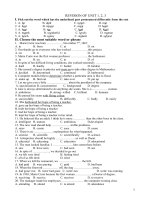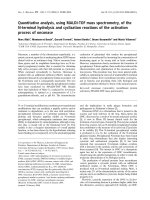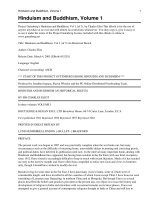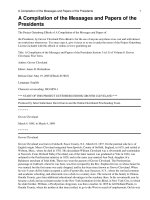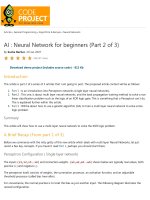Organocatalytic reactions of 3 hydroxy 2 pyrone and n arylsulfonyl 3 hydroxy 2 pyridone 4
Bạn đang xem bản rút gọn của tài liệu. Xem và tải ngay bản đầy đủ của tài liệu tại đây (1.19 MB, 60 trang )
Chapter 4
74
Chapter4
Experimental Section
Chapter 4
75
4.1 General procedures and methods
All reactions were performed in oven-dried round bottom flasks or glass vials. The
flasks were fitted with rubber septa and reactions were conducted under a positive
pressure of nitrogen, unless otherwise noted. Stainless steel syringes or cannulae were
used to transfer air- and moisture-sensitive liquids. Analytical thin layer chromatography
(TLC) was performed with Merck pre-coated TLC plates, silica gel 60F-254, layer
thickness 0.25 mm. Flash column chromatography was performed using Merck 60 (0.040
– 0.063 mm) mesh silica gel.
Commercial reagents were purchased from Sigma Aldrich, Fluka, Alfa Aesar or
Lancaster, and used as received. All solvent distillation was done at 760 Torr. THF was
distilled from sodium/benzophenone; diethyl ether was distilled from sodium wire;
CH
2
Cl
2
was distilled from calcium hydride.
Proton nuclear magnetic resonance (
1
H NMR) and carbon nuclear magnetic
resonance (
13
C NMR) spectra were recorded on a Bruker AMX500 (500MHz) NMR
spectrometer. Deuterated solvent used was CDCl
3
. Chemical shifts for protons were
reported in parts per million (ppm) downfield from tetramethylsilane and are referenced
to the NMR solvent (δ 7.26). Chemical shifts for carbon were reported in parts per
million (ppm) downfield from tetramethylsilane and were referenced to the carbon
resonances of the solvent (δ 77.0). Data were represented as follows: chemical shift,
integration, multiplicity (s = singlet, d = doublet, t = triplet, q = quartet, m = multiplet)
and coupling constants (J) in Hertz (Hz). Both low and high resolution mass spectra were
Chapter 4
76
obtained on a Finnigan/MAT 95XL-T mass spectrometer in FAB mode. Infrared spectra
were recorded on a BIO-RAD FTS 165 FTIR spectrometer. Enantiomeric excesses were
determined using chiral HPLC analysis on Hewlett Packard Ti-series 1050 HPLC units.
Optical rotations were recorded on a Jasco DIP-1000 polarimeter. Melting points were
determined on a BUCHI B-540 melting point apparatus.
Single crystal X-Ray diffraction studies were obtained on a Bruker-AXS Smart
Apex CCD single-crystal diffractometer. Crystals were grown from iso-propanol and
dichloromethane solutions and mounted on glass fibres. X-ray data were collected with a
Bruker AXS SMART APEX diffractometer, using Mo-K
α radiation at room temperature,
with the SMART suite of Programs(1). Data were processed and corrected for Lorentz
and polarisation effects with SAINT(2), and for absorption effect with SADABS(3).
Structural solution and refinement were carried out with the SHELXTL, suite of
programs (4). The structure was solved by direct methods to locate the heavy atoms,
followed by difference maps for the light, non-hydrogen atoms. All non-hydrogen atoms
were generally given anisotropic displacement parameters in the final model. All H-
atoms were put at calculated positions.
1. SMART version 5.628, 2001. Bruker AXS Inc., Madison, Wisconsin, USA
2. SAINT+ version 6.22a, 2001 Bruker AXS Inc., Madison, Wisconsin, USA
3. SADABS, version 2.10, 2001 G. W. Sheldrick, University of Göttingen
4. SHELXTL, Version 6.14, 2000, Bruker AXS Inc., Madison, Wisconsin, USA
Chapter 4
77
4.2 Typical experimental procedures
4.2.1 General procedure for Vinylogous Aldol Reaction of 3-hydroxy-2-pyrone and
aldehydes.
To a 4 ml sample vial containing 1 (11.1 mg, 0.10 mmol, 1.0 eq.), TBD (2.1 mg, 0.015
mmol, 0.15 eq.) was added, followed by 0.5 ml of DMSO. The reaction mixture was
stirred for 15 minutes for complete dissolution of 1. The appropriate aldehyde (4 eq.) was
next added and allowed to stir under room conditions. After the reaction is complete, 1ml
of deionised water is added. The mixture was extracted with CHCl
3
(3x1.5ml) till the
product was transferred to the organic phase. The organic extracts are collected and dried
using Na
2
SO
4
. The solvent was removed under reduced pressure and the residue was
loaded onto a short silica gel column, followed by flash column chromatography
(gradient elution with hexane:ethyl acetate: 9/1 to 1/1). Product VAP was obtained as a
yellow liquid (75% yield).
Chapter 4
78
4.2.2 General procedure for Diels-Alder reaction of 3-hydroxy-2-pyrone and N-
mesityl-maleimide.
To a 4 ml sample vial containing catalyst 8a (1.6 mg, 0.008 mmol, 0.1 eq.), 3-hydroxy-2-
pyrone (9.0 mg, 0.080 mmol, 1.0 eq.) was added, followed by 1.0 ml of solvent. The
reaction mixture was placed in a cryobath preset at -50
o
C and allowed to stir for an hour.
N-mesityl-maleimide (51.6 mg, 0.240 mmol, 3.0 eq.) was then added. After stirring for
20 hrs, the solvent was removed under reduced pressure and the residue was loaded onto
a short silica gel column, followed by flash column chromatography (gradient elution
with hexane:ethyl acetate: 9/1 to 1/1). Product 5a was obtained as a white solid in 73%
yield (major isomer).
4.2.3 General procedure for the synthesis of amino indanol catalysts.
1
1,4-dibromobutane (0.115 ml, 0.973 mmol, 1.2 eq.) was added to a mixture containing
(1R,2S)-amino alcohol (121.0 mg, 0.811 mmol, 1.0 eq.), potassium iodide (26.9 mg,
Chapter 4
79
0.162 mmol, 0.2 eq.) and potassium carbonate (291.0 mg, 2.110 mmol, 2.6 eq.) in a
sealed tube. 2ml of iso-propanol was added and the reaction tube capped. The mixture
was refluxed at 80
o
C for 24hrs and then allowed to cool to room temperature. The
mixture was poured into 4 ml of deionized water and extracted with ethyl acetate. The
organic extracts were dried with Na
2
SO
4
and the solvent was removed under reduced
pressure. The residue was purified by flash column chromatography on silica gel, eluting
with hexane:ethyl acetate (1:4), yielding 8a (0.1244 g) as a yellow liquid in 75% yield.
4.2.4 General procedure for Diels-Alder reaction of N-arylsulfonyl-3-hydroxy-2-
pyridone and N-substituted-maleimides.
N
OH
O
SO
2
Ar
N
O
O
R
10 mol%
8a
N
O
SO
2
A
r
HO
+
4b
: Ar = 2,4,6-Me
3
C
6
H
2
(Mes)
4c
: Ar = 3,5-Me
2
C
6
H
3
4d
: Ar = 2,3,4,5,6-Me
5
C
6
N
O
O
R
CHCl
3
, 20h
Ar = Mes, R = Ph,
6a
Ar = Mes, R = Et,
6b
Ar = Mes, R = Bn,
6c
Ar = Mes, R = 4-OEtC
6
H
4
,
6d
Ar = Mes, R = 4-MeC
6
H
4
,
6e
Ar = Mes, R = 4-BrC
6
H
4
,
6f
Ar = Mes, R = 3,4-Cl
2
C
6
H
3
,
6g
Ar = 3,5-Me
2
C
6
H
3
,R=Ph,
6h
Ar = 2,3,4,5,6-Me
5
C
6
,R=Ph,
6j
2
To a 4 ml sample vial containing catalyst 8a (1.0 mg, 0.005 mmol, 0.1 eq.), 4b (14.7 mg,
0.050 mmol, 1.0 eq.) was added, followed by 0.5 ml of CHCl
3
. The reaction mixture was
placed in a cryobath preset at -50
0
C and allowed to stir for an hour. N-phenyl maleimide
(26.0 mg, 0.150 mmol, 3.0 eq.) was then added. After stirring for 18 hrs, the solvent was
removed under reduced pressure and the residue was loaded onto a short silica gel
Chapter 4
80
column, followed by flash column chromatography (gradient elution with hexane:ethyl
acetate: 9/1 to 1/1). Product 6a was obtained as a white solid in 93% yield (21.7 mg) and
93% ee.
4.2.5 General procedure for the synthesis of N-arylsulfonyl-3-hydroxy-2-pyridone.
Pyridones 4b, 4c and 4d were prepared according to the published procedure.
2
4.2.6 Procedure for the synthesis of 9a
3
To a solution of 4b (219.9 mg, 0.750 mmol, 1.0 eq.) in PhMe (6 ml) was added i-Pr
2
NH
(10.5 µl, 0.075 mmol, 0.10 eq). The solution was stirred for 15 minutes under room
conditions. SO
2
Cl
2
(79.0 µl, 0.975 mmol, 1.3 eq.) was added and the reaction was heated
at 70
0
C for 30 minutes. After cooling to room temperature, deionised water (5 ml) was
added and the mixture was diluted with EtOAc (10 ml). Extraction was done with
additional EtOAc (2 x 10 ml). The organic extracts were dried over Na
2
SO
4
and
concentrated under reduced pressure. Purification of the crude using flash column
chromatography yielded the product.
(9a) White solid, 75% yield.
m.p. : 182.5-183.5
0
C
Chapter 4
81
1
H NMR (500 MHz CDCl
3
ppm): δ 2.32 (s, 3H), 2.58 (s, 6H), 6.36 (d, 1H, J = 8.2 Hz),
6.85 (s, 1H), 7.00 (s, 2H), 7.67 (d, 1H, J = 8.2 Hz).
13
C NMR (125 MHz CDCl
3
ppm): δ 21.2, 22.5, 108.8, 120.8, 122.8, 130.4, 132.2, 141.4,
143.6, 145.4, 156.4.
FTIR (KBr): 648, 685, 1123, 1174, 1365, 1618, 1638, 2978, 3269 cm
-1
.
LRMS (FAB) m/z 328.2 (M+H
+
)
HRMS (FAB) m/z 328.0402 (M+ H
+
), calc. for C
14
H
15
NO
4
35
ClS 328.0405
4.2.7 Procedure for the synthesis of 9b
4
CH
2
Cl
2
, 3 h, 78%
N
O
OH
SO
2
Mes
Br
N
O
OH
SO
2
Mes
9b
4b
NBS, (i-Pr)
2
NH
To a solution of 4b (198.9 mg, 0.679 mmol, 1.0 eq.) in CH
2
Cl
2
(2 ml) was added i-
Pr
2
NH (9.5 µl, 0.068 mmol, 0.10 eq.). The solution was stirred for 15 minutes under
ambient conditions. N-Bromosuccinimide (1.1 eq.) (132.9 mg in 5 ml CH
2
Cl
2
) was added
portionwise over a period of 30 minutes. Stirring was continued for an additional 30
minutes. Deionised water (5 ml) was added and the mixture was diluted with CH
2
Cl
2
(10ml). Extraction was done with additional CH
2
Cl
2
(2 x 10 ml). The organic extracts
were dried over Na
2
SO
4
and concentrated under reduced pressure. Purification of the
crude using flash column chromatography yielded the above product.
(9b) White solid, 78% yield.
m.p. : 163.0-164.5
0
C
Chapter 4
82
1
H NMR (500 MHz CDCl
3
ppm): δ 2.32 (s, 3H), 2.58 (s, 6H), 6.48 (d, 1H, J = 8.2 Hz),
7.00 (s, 2H), 7.61 (d, 1H, J = 8.2 Hz).
13
C NMR (125 MHz CDCl
3
ppm): δ 21.2, 22.5, 110.8, 111.5, 120.8, 130.4, 132.2, 141.4,
145.3, 145.4, 155.7.
FTIR (KBr): 642, 678, 1174, 1363, 1636, 2920, 3287 cm
-1
.
LRMS (FAB) m/z 372.0 (M+H
+
); 374.0 (M+H
+
)
HRMS (FAB) m/z 371.9888 (M+ H
+
), calc. for C
14
H
15
NO
4
79
BrS 371.9900
HRMS (FAB) m/z 373.9870 (M+ H
+
), calc. for C
14
H
15
N
1
O
4
81
BrS 373.9879
4.2.8 Procedure for the synthesis of 9c
5
N
O
OH
SO
2
Mes
K
2
CO
3
,KI
MeCN, reflux, 95%
N
O
O
SO
2
Mes
Br
4b
To a mixture containing 4b (139.6 mg, 0.476 mmol, 1.0 eq.), K
2
CO
3
(197.5 mg, 1.429
mmol, 3.0 eq.) and KI (7.9 mg, 0.048 mmol, 0.10 eq.) was added MeCN (3 ml). Allyl
bromide (45.3 µl, 0.524 mmol, 1.1 eq.), was next added and the reaction mixture was
heated at reflux for 2 hours. After cooling to room temperature, water (5 ml) was added.
The mixture was diluted with EtOAc (10ml) and extracted with additional EtOAc (2 x 10
ml). The organic extracts were dried over Na
2
SO
4
and concentrated under reduced
pressure. Purification of the crude using flash column chromatography yielded the above
product.
White solid, 95% yield.
Chapter 4
83
1
H NMR (500 MHz CDCl
3
ppm): δ 2.26 (s, 3H), 2.57 (s, 6H), 4.44 (d, 2H, J = 5.7 Hz),
5.24 (dd, 1H, J = 1.3, 10.7 Hz), 5.32 (dd, 1H, J = 1.3, 22.7 Hz), 5.95 (ddd, 1H, J = 5.7,
10.7, 22.7 Hz), 6.17 (dd, 1H, J = 6.9, 7.6 Hz), 6.56 (dd, 1H, J = 1.3, 7.6 Hz), 6.92 (s, 2H),
7.73 (dd, 1H, J = 1.3, 6.9 Hz).
13
C NMR (125 MHz CDCl
3
ppm): δ 21.0, 22.4, 69.9, 104.4, 114.0, 118.8, 122.7, 131.2,
131.8, 131.9, 141.1, 144.4, 149.6, 156.6.
FTIR (KBr): 665, 688, 756, 1010, 1126, 1169, 1272, 1349, 1609, 1673, 2925 cm
-1
.
LRMS (FAB) m/z 334.1 (M+H
+
)
HRMS (FAB) m/z 334.1111 (M+ H
+
), calc. for C
17
H
20
N
1
O
4
S 334.1108
O-allyl-protected 4b was dissolved in N,N-dimethylaniline (1 ml). The solution was
heated at 190
0
C for 30 minutes. After cooling to room temperature, 10 % HCl was added
till the pH is neutral and the solution was diluted with EtOAc (10ml) and extracted with
additional EtOAc (2 x 10 ml). The organic extracts were dried over Na
2
SO
4
and
concentrated under reduced pressure. Purification using flash column chromatography
yielded the above product as a white solid.
(9c) White solid, 75% yield.
m.p. : 138.2-139.5
0
C
Chapter 4
84
1
H NMR (500 MHz CDCl
3
ppm): δ 2.31 (s, 3H), 2.59 (s, 6H), 3.27 (d, 2H, J = 6.9 Hz),
5.12 (m, 1H), 5.14 (m, 1H), 5.86 (m, 1H), 6.19 (d, 1H, J = 7.6 Hz), 6.47 (s, 1H), 6.98 (s,
2H), 7.65 (d, 1H, J = 7.6 Hz).
13
C NMR (125 MHz CDCl
3
ppm): δ 21.2, 22.5, 33.0, 108.6, 117.5, 120.6, 127.4, 131.1,
132.1, 133.5, 141.2, 143.6, 144.9, 157.1.
FTIR (KBr): 658, 684, 1172, 1367, 1614, 1650, 2976, 3307 cm
-1
.
LRMS (FAB) m/z 334.2 (M+H
+
)
HRMS (FAB) m/z 334.1122 (M+ H
+
), calc. for C
17
H
20
NO
4
S 334.1108
4.2.9 Procedure for the synthesis of 9d
To a solution containing 9c (133.2 mg, 0.400 mmol, 1.0 eq.) dissolved in EtOAc (5 ml)
was added Pd/C (10 % by weight). Bubbling of hydrogen gas for 15 minutes and the
reaction mixture was stirred for a further 4 hours under a positive atmosphere of
hydrogen gas (balloon). The reaction mixture was filtered and flash column
chromatography yielded the titled compound as a white solid.
(9d) White solid, 90% yield. m.p.: 156.5-157.5
0
C
Chapter 4
85
1
H NMR (500 MHz CDCl
3
ppm): δ 0.94 (t, 2H, J = 7.6 Hz), 1.60 (sextet, 2H, J = 7.6 Hz),
2.31 (s, 3H), 2.48 (t, 2H, J = 7.6 Hz), 2.59 (s, 6H), 6.18 (d, 1H, J = 8.2 Hz), 6.42 (s, 1H),
6.98 (s, 2H), 7.64 (d, 1H, J = 8.2 Hz).
13
C NMR (125 MHz CDCl
3
ppm): δ 13.8, 21.2, 21.5, 22.5, 31.0, 109.1, 120.4, 130.2,
131.2, 132.1, 141.2, 143.6, 144.9, 157.1.
FTIR (KBr): 669, 1169, 1371, 1544, 1606, 1652, 2925, 2961, 3341 cm
-1
.
LRMS (FAB) m/z 336.1 (M+H
+
)
HRMS (FAB) m/z 336.1266 (M+ H
+
), calc. for C
17
H
22
NO
4
S 336.1264
4.2.10 Procedure for the synthesis of 9e
6
The procedure for the protection of the alcohol is the same as for the synthesis of 4b.
White solid, 85% yield.
1
H NMR (500 MHz CDCl
3
ppm): δ 0.04 (s, 6H), 0.92 (s, 9H), 2.30 (s, 6H), 2.57 (s, 6H),
6.39 (d, 1H, J = 8.2 Hz), 6.94 (s, 2H), 7.59 (d, 1H, J = 8.2 Hz).
13
C NMR (125 MHz CDCl
3
ppm): δ 18.8, 21.1, 22.5, 25.8, 109.8, 119.2, 122.2, 131.0,
131.8, 141.5, 144.6, 145.4, 156.2.
FTIR (KBr): 681, 740, 1176, 1354, 1604, 1677, 2857, 2930 cm
-1
.
LRMS (FAB) m/z 486.2 (M+H
+
); 488.2 (M+H
+
)
HRMS (FAB) m/z 486.0773 (M+ H
+
), calc. for C
20
H
29
NO
4
79
BrSSi
486.0764
Chapter 4
86
HRMS (FAB) m/z 488.0762 (M+ H
+
), calc. for C
20
H
29
NO
4
81
BrSSi
488.0744
A modified procedure for the Suzuki coupling was carried out.
O-TBS-protected 9b (34.1 mg, 0.070 mmol, 1.0 eq.) and 4-chloro-phenyl boronic acid
(10.6 mg, 0.084 mmol, 1.2 eq.) were dissolved in 2-propanol (1 ml). The mixture was
stirred for 30 minutes allowing complete dissolution of all solids. Palladium acetate (0.8
mg, 0.0035 mmol, 0.05 eq.), tricyclohexylphosphine (2.0 mg, 0.0070 mmol, 0.10 eq.) and
2M aqueous sodium carbonate (70 µl) were added. The reaction mixture was heated at
reflux for 1.5 hours. After cooling to room temperature, water (5 ml) was added. The
mixture was diluted with EtOAc (10ml) and extracted with additional EtOAc (2 x 10 ml).
The organic extracts were dried over Na
2
SO
4
and concentrated under reduced pressure.
Purification of the crude using flash column chromatography yielded the above product
which was subjected to desilylation with BF
3
.Et
2
O. The procedure for the desilylation of
the TBS group is the same as for the synthesis of 4b.
(9e) White solid, 75% yield for 2 steps.
m.p. : 168.5-169.0
0
C
Chapter 4
87
1
H NMR (500 MHz CDCl
3
ppm): δ 2.33 (s, 3H), 2.63 (s, 6H), 6.46 (d, 1H, J = 8.2 Hz),
6.95 (s, 1H), 7.01 (s, 2H), 7.42 (d, 2H, J = 8.8 Hz), 7.64 (d, 2H, J = 8.8 Hz), 7.76 (d, 1H,
J = 8.2 Hz).
13
C NMR (125 MHz CDCl
3
ppm): δ 21.2, 22.6, 107.6, 120.8, 125.0, 128.8, 129.9, 130.8,
132.2, 132.5, 134.9, 141.4, 143.0, 145.2, 157.8.
FTIR (KBr): 639, 681, 1169, 1367, 1616, 1650, 3309 cm
-1
.
LRMS (FAB) m/z 404.0 (M+H
+
)
HRMS (FAB) m/z 404.0731 (M+H
+
), calc. for C
20
H
19
NO
4
35
ClS 404.0718
4.2.11 General procedure for Diels-Alder reaction of N-arylsulfonyl-4-substituted-
3-hydroxy-2-pyridone and N-substituted-maleimides
The procedure is the same for the synthesis of the adducts 6a-j.
Chapter 4
88
4.2.12 General procedure for Diels-Alder reaction of N-arylsulfonyl-3-hydroxy-2-
pyridone and alkyl vinyl ketones.
To a 4 ml sample vial containing catalyst 8a (3.3 mg, 0.016 mmol, 0.2 eq.), 4b (23.4 mg,
0.080 mmol, 1.0 eq.) was added, followed by 0.2 ml of CHCl
3
. The reaction mixture was
stirred for 15 min until a clear solution was obtained. 0.5 ml of methyl vinyl ketone
(excess) was then added. The reaction mixture was capped and placed in a cryobath
preset at -40
o
C. After stirring for 48 hrs, the solvent was removed under reduced pressure
and the residue was dissolved in 1 ml of CH
2
Cl
2
. It was washed with deionised water (1
ml), 1% HCl (1 ml) and deionised water (1 ml) again. After drying with Na
2
SO
4
, the
solvent was removed under pressure and purified using flash column chromatography to
give a mixture of endo and exo products (~ 3:1 by HPLC) in 85% yield.
Chapter 4
89
4.2.13 General procedure for Michael reaction of N-arylsulfonyl-3-hydroxy-2-
pyridone and β-nitro styrenes.
To a 4 ml sample vial containing catalyst 8a (3.3 mg, 0.016 mmol, 0.2 eq.), 4b (23.4 mg,
0.080 mmol, 1.0 eq.) was added, followed by 0.5 ml of solvent. The reaction mixture was
placed in a cryobath preset at 0
o
C and allowed to stir for an hour. 1-nitro-2-(2-
nitrovinyl)benzene (46.6 mg, 0.240 mmol, 3.0 eq.) was then added. After stirring for 72
hrs, the solvent was removed under reduced pressure and the residue was loaded onto a
short silica gel column, followed by flash column chromatography (gradient elution with
hexane:ethyl acetate: 9/1 to 1/1). Product 13a was obtained as a white solid in 75% yield.
References
1) Ju, Y.; Varma, R. S. J. Org. Chem. 2006, 71, 135.
2) Böhm, M.; Lorthiois, E.; Meyyappan, M.; Vasella, A. Helv. Chim. Acta 2003, 86,
3787–3817.
3) Gnaim, J. M.; Sheldon, R. A. Tetrahedron Lett. 1995, 36, 3893.
4) Fujisaki, S.; Eguchi, H.; Omura, A.; Okamoto, A.; Nishida, A. Bull. Chem. Soc.
Jpn. 1993, 66, 1576.
5) Moffett, R. B. J. Org. Chem. 1963, 28, 2885.
6) Littke, A. F.; Dai, C.; Fu, G. C. J. Am. Chem. Soc. 2000, 122, 4020–4028.
Chapter 4
90
4.3 Characterization of compounds.
4.3.1 Characterisation of Vinylogous Aldol Product.
(VAP1) Yellow liquid, 75% yield.
1
H NMR (500 MHz CDCl
3
ppm): δ 5.57 (s, 1H), 6.23 (d, 1H, J =
7.6 Hz), 6.66 (d, 1H, J = 7.6 Hz), 7.57 (d, 1H, J = 8.2 Hz), 7.69 (d,
1H, J = 8.2 Hz).
13
C NMR (125 MHz CDCl
3
ppm): δ 72.0, 103.6, 114.3, 127.4,
132.6.
FTIR (film): 1079, 1216, 1410, 1520, 2974, 3019 cm
-1
.
LRMS (FAB) m/z 242.0 (M
-
)
HRMS (FAB) m/z 242.0459 (M
-
), calc. for C
13
H
8
NO
4
242.0448
4.3.2 Characterisation of amino indanol catalysts.
(8a) (1R,2S)-2,3-dihydro-1-(pyrrolidin-1-yl)-1H-inden-2-ol
Yellow liquid, 75% yield.
1
H NMR (500 MHz CDCl
3
ppm): δ 1.70-1.79 (m, 4H), 2.54-2.59 (m,
2H), 2.74-2.77 (m, 2H), 2.58 (dd, 1H, J = 7.6, 16.4 Hz), 3.20 (dd, 1H, J = 7.6, 15.8 Hz),
4.27 (d, 1H, J = 7.6 Hz), 4.43 (dd, 1H, J = 7.6, 14.5 Hz), 7.17-7.33 (m, 4H).
13
C NMR (125 MHz CDCl
3
ppm): δ 23.4, 40.8, 50.5, 66.4, 70.3, 125.5, 126.2, 126.4,
128.4, 139.1, 141.9.
FTIR (film): 1079, 1216, 1410, 1520, 2974, 3019 cm
-1
.
LRMS (FAB) m/z 204.2 (M+H
+
)
HRMS (FAB) m/z 204.1376 (M+H
+
), calc. for C
13
H
18
NO 204.1383
O
OH
O
OH
NC
N
OH
Chapter 4
91
(8b) (1R,2R)-2,3-dihydro-1-(pyrrolidin-1-yl)-1H-inden-2-ol
Yellow liquid, 70% yield.
1
H NMR (500 MHz CDCl
3
ppm): δ 1.78-1.81 (m, 4H), 2.72-2.81 (m,
5H), 2.98 (s, 1H), 3.35 (dd, 1H, J = 6.3, 16.4 Hz), 4.05 (d, 1H, J = 3.2 Hz), 4.57 (dd, 1H,
J = 3.8, 6.3 Hz), 7.17-7.20 (m, 1H), 7.22-7.24 (m, 2H), 7.33-7.34 (m, 2H).
13
C NMR (125 MHz CDCl
3
ppm): δ 23.6, 40.1, 50.5, 75.3, 75.3, 125.4, 126.3, 126.3,
128.1, 140.1, 141.4.
FTIR (film): 1083, 1220, 1415, 1533, 2960, 3010 cm
-1
.
LRMS (FAB) m/z 204.2 (M+H
+
)
HRMS (FAB) m/z 204.1380 (M+H
+
), calc. for C
13
H
18
NO
204.1383
(8c) (1R,2S)-2,3-dihydro-1-(piperidin-1-yl)-1H-inden-2-ol
White crystalline solid, 75% yield.
m.p. : 91.0
o
C
1
H NMR (500 MHz CDCl
3
ppm): δ 1.40-1.41 (m, 2H), 1.55-1.61 (m, 4H), 2.38 (m, 2H),
2.57 (m, 2H), 2.77 (dd, 1H, J = 7.6, 16.4 Hz), 3.29 (dd, 1H, J = 8.2, 16.4 Hz), 4.05 (d, 1H,
J = 8.2 Hz), 4.43 (dd, 1H, J = 7.6, 15.8 Hz), 7.19-7.27 (m, 3H), 7.31-7.32 (m, 1H).
13
C NMR (125 MHz CDCl
3
ppm): δ 24.1, 26.6, 41.8, 52.6, 69.0, 70.8, 125.5, 126.4, 128.4,
138.9, 141.7.
FTIR (KBr): 860, 1167, 1310, 1383, 2687, 2807, 2928, 3111 cm
-1
.
LRMS (FAB) m/z 218.3 (M+H
+
)
HRMS (FAB) m/z 218.1532 (M+H
+
), calc. for C
14
H
20
NO
218.1539
N
OH
N
OH
Chapter 4
92
(8d) (1R,2S)-2,3-dihydro-1-(isoindolin-2-yl)-1H-inden-2-ol
White crystalline solid, 73% yield.
m.p. : 88.0-89.0
o
C
1
H NMR (500 MHz CDCl
3
ppm): δ 2.89 (dd, 1H, J = 6.9, 7.6, 16.1
Hz), 3.28 (dd, 1H, J = 6.9, 7.6, 16.1 Hz), 4.03 (d, 1H, J = 10.7 Hz), 4.21 (d, 1H, J = 11.4
Hz), 4.48 (d, 1H, J = 6.9 Hz), 4.54 (q, 1H, J = 6.9, 14.5 Hz), 7.17-7.22 (m, 5H), 7.26-7.29
(m, 2H), 7.36-7.38 (m, 1H).
13
C NMR (125 MHz CDCl
3
ppm): δ 40.7, 56.0, 66.8, 70.8, 122.2, 125.5, 126.8, 126.8,
128.6, 139.1, 139.4, 141.7.
FTIR (KBr): 860, 1059, 1167, 1310, 1460, 2807, 2687, 2928, 3113 cm
-1
.
LRMS (FAB) m/z 252.1 (M+H
+
)
HRMS (FAB) m/z 252.1371 (M+H
+
), calc. for C
17
H
18
NO
252.1383
4.3.3 Characterisation of N-arylsulfonyl-3-hydroxy-2-pyridones.
(4b) White solid, 65% yield.
m.p. : 141.0-142.5
0
C
1
H NMR (500 MHz CDCl
3
ppm): δ 2.32 (s, 3H), 2.59 (s, 6H), 6.27 (dd,
1H, J = 6.9, 7.6 Hz), 6.78 (dd, 1H, J = 1.3, 6.9 Hz), 6.99 (s, 2H), 7.70 (dd, 1H, J = 1.3,
7.6 Hz).
N
OH
N
O
OH
SO
2
Mes
Chapter 4
93
13
C NMR (125 MHz CDCl
3
ppm): δ 21.3, 22.5, 106.3, 114.3, 121.7, 131.0, 132.2, 141.3,
145.1, 147.2, 157.7.
FTIR (KBr): 673, 744, 1119, 1171, 1286, 1359, 1636, 1659, 2941, 3122, 3399 cm
-1
.
LRMS (FAB) m/z 294.1 (M+H
+
)
HRMS (FAB) m/z 294.0787 (M+ H
+
), calc. for C
14
H
16
NO
4
S
294.0795
(4c) White solid, 60% yield.
m.p. : 145.0-146.0
0
C
1
H NMR (500 MHz CDCl
3
ppm): δ 2.41 (s, 6H), 6.25 (dd, 1H, J = 6.9, 7.6
Hz), 6.76 (dd, 1H, J = 1.3, 6.9 Hz), 7.31 (s, 1H), 7.66 (dd, 1H, J = 1.3, 7.6
Hz), 7.70 (s, 2H).
13
C NMR (125 MHz CDCl
3
ppm): δ 21.2, 106.9, 114.2, 121.5, 127.0, 136.0, 136.9, 139.2,
147.2, 157.4.
FTIR (KBr): 683, 806, 1119, 1174, 1254, 1297, 1402, 1429, 1627, 1651, 2923, 3302 cm
-1
.
LRMS (FAB) m/z 280.2 (M+H
+
)
HRMS (FAB) m/z 280.0642 (M+ H
+
), calc. for C
13
H
14
NO
4
S
280.0638
(4d) White solid, 50% yield.
m.p. : 140.0-141.5
0
C
1
H NMR (500 MHz CDCl
3
ppm): δ 2.26 (s, 6H), 2.30 (s, 3H), 2.52 (s, 6H),
6.29 (dd, 1H, J = 6.9, 7.6 Hz), 6.43 (s, 1H, OH), 6.79 (dd, 1H, J = 1.9, 6.9
Hz), 7.71 (dd, 1H, J = 1.9, 7.6 Hz).
N
O
OH
S
O
O
N
O
OH
S
O
O
Chapter 4
94
13
C NMR (125 MHz CDCl
3
ppm): δ 17.2, 18.1, 18.3, 106.5, 114.1, 121.2, 133.3, 135.4,
135.9, 142.5, 147.1, 157.6.
FTIR (KBr): 649, 743, 1119, 1166, 1214, 1354, 1393, 1622, 1655, 2924, 3287 cm
-1
.
LRMS (FAB) m/z 322.2 (M+H
+
)
HRMS (FAB) m/z 322.1121 (M+ H
+
), calc. for C
16
H
20
N
1
O
4
S
322.1108
4.3.4 Characterisation of Diels-Alder Products.
(4d) White solid, 73% yield (major isomer), 90% ee.
[α]
D
28
: +158.1 (c 0.21, CHCl
3
)
m.p. : 155.0-157.0
o
C
1
H NMR (500 MHz CDCl
3
ppm): δ 2.00 (s, 3H), 2.02 (s, 3H), 2.29 (s,
3H), 3.33 (d, 1H, J = 8.2 Hz), 3.97 (dd, 1H, J = 4.4, 8.2 Hz), 4.00 (s, 1H), 5.70 (m, 1H),
6.59 (dd, 1H, J = 5.0, 8.2 Hz), 6.67 (m, 1H), 6.94 (s, 1H), 6.95 (s, 1H).
13
C NMR (125 MHz CDCl
3
ppm): δ 17.8, 18.7, 21.0, 43.6, 46.7, 72.2, 75.1, 126.7, 128.9,
129.5, 129.6, 134.7, 135.4, 137.8, 140.0, 171.6, 171.8, 171.9.
FTIR (KBr): 975, 1141, 1194, 1378, 1716, 1768, 2923, 2959, 3471 cm
-1
.
LRMS (FAB) m/z 328.1 (M+H
+
)
HRMS (FAB) m/z 328.1271 (M+ H
+
), calc. for C
18
H
18
NO
5
328.1371
The enantiomeric excess was determined by chiral HPLC; CHIRALPAK OC-H (4.6 mm
i.d. x 250 mm); methanol/2-propanol 50/50; flow rate 0.5 ml/min; temp 25
0
C; detection
UV 224 nm; retention time 14.0 min (minor) and 16.6 min (major).
O
O
HO
N
O
O
Chapter 4
95
min
0 5 10 15 20
mAU
0
200
400
600
800
1000
1200
1400
VWD1 A, Wav elength=224 nm (JULIAN\T1112301.D)
13.901
16.469
min
0 5 10 15 20
mAU
0
50
100
150
200
250
300
VWD1 A, Wav elength=224 nm (JULIAN\T11120B1.D)
A
rea:
1014.99
14.038
16.621
(6a) White solid, 93% yield, 93% ee.
[α]
D
28
: +97.8 (c 1.0, CHCl
3
)
m.p. : 199.0-200.0
o
C
1
H NMR (500 MHz CDCl
3
ppm): δ 2.31 (s, 3H), 2.61 (s, 6H), 3.26
(d, 1H, J = 7.6 Hz), 3.91 (dd, 1H, J = 3.8, 8.2 Hz), 4.11 (s, 1H),
5.89 (m, 1H), 6.50 (dd, 1H, J = 1.3, 8.2 Hz), 6.56 (dd, 1H, J = 5.7,
8.2 Hz), 6.98 (s, 2H), 7.18-7.20 (m, 2H), 7.39-7.47 (m, 3H).
13
C NMR (125 MHz CDCl
3
ppm): δ 21.1, 22.6, 25.3, 44.6, 47.8, 51.4, 78.0, 126.2, 129.0,
129.1, 129.2, 131.1, 131.5, 132.2, 137.3, 141.0, 144.7, 170.5, 172.1, 172.5.
FTIR (KBr): 677, 904, 1104, 1164, 1346, 1391, 1717, 1745, 2982, 3513 cm
-1
.
LRMS (FAB) m/z 467.1 (M+H
+
)
N
HO
O
S
O
O
N
O
O
Chapter 4
96
HRMS (FAB) m/z 467.1271 (M+ H
+
), calc. for C
24
H
23
N
2
O
6
S
467.1271
The enantiomeric excess was determined by chiral HPLC; CHIRALPAK AS-H (4.6 mm
i.d. x 250 mm); hexane/2-propanol 5/95; flow rate 0.7 ml/min; temp 25
0
C; detection UV
240 nm; retention time 20.0 min (major) and 48.4 min (minor).
min
0 10 20 30 40 50 60
mAU
0
50
100
150
200
250
VWD1 A, Wav elength=240 nm (JULIAN\YT8082B1.D)
20.42
6
47.708
min
0 10 20 30 40 50 60
mAU
0
200
400
600
800
1000
1200
1400
VWD1 A, Wav elength=240 nm (JULIAN\YT815600.D)
20.03
9
A
r
e
a:
7
7
2
3.07
48.424
(6b) White solid, 92% yield, 87% ee.
[α]
D
28
: +77.3 (c 1.0, CHCl
3
)
m.p. : 181.0-182.0
o
C
1
H NMR (500 MHz CDCl
3
ppm): δ 1.10 (t, J = 7.6 Hz), 2.30 (s, 3H),
2.26 (s, 6H), 3.09 (d, 1H, J = 8.2 Hz), 3.51 (q, 2H, J = 6.9, 7.6 Hz),
3.72 (dd, 1H, J = 3.8, 8.2 Hz), 4.03 (s,1H), 5.78-5.81 (m, 1H), 6.36-6.37 (m, 1H), 6.44
(dd, 1H, J = 5.7, 8.2 Hz), 6.96 (s, 2H).
N
O
HO
N
O
O
Et
S
O
O
Chapter 4
97
13
C NMR (125 MHz CDCl
3
ppm): δ 12.7, 21.1, 22.5, 34.2, 44.4, 47.7, 51.3, 77.9, 128.6,
131.6, 132.2, 137.1, 141.0, 144.7, 170.6, 172.9, 173.3.
FTIR (KBr): 675, 1102, 1137, 1171, 1232, 1346, 1686, 1736, 2943, 3438 cm
-1
.
LRMS (FAB) m/z 419.1 (M+H
+
)
HRMS (FAB) m/z 419.1266 (M+H
+
), calc. for C
20
H
23
N
2
O
6
S
419.1271
The enantiomeric excess was determined by chiral HPLC; CHIRALPAK AS-H (4.6 mm
i.d. x 250 mm); hexane/2-propanol 5/95; flow rate 0.7 ml/min; temp 25
0
C; detection UV
210 nm; retention time 12.5 min (major) and 34.9 min (minor).
mi
n
0 10 20 30 40
mAU
0
100
200
300
400
500
VWD1 A, Wav elength=210 nm (JULIAN\YT8162A0.D)
12.62
3
34.918
min
0 5 10 15 20 25 30 35 40 45
mAU
0
200
400
600
800
1000
VWD1 A, Wav elength=210 nm (JULIAN\YT8157A2.D)
12.52
3
A
r
ea: 700
5
.
8
4
34.885
Chapter 4
98
(6c) White solid, 90% yield, 89% ee.
[α]
D
28
: +59.1 (c 2.8, CHCl
3
)
m.p. : 102.0-103.0
o
C
1
H NMR (500 MHz CDCl
3
ppm): δ 2.29 (s, 3H), 2.55 (s, 6H),
3.09 (d, 1H, J = 8.2 Hz), 3.72 (dd, 1H, J = 3.8, 8.2 Hz), 4.01 (s,
1H), 4.59 (d, 2H, J = 6.9 Hz), 5.74-5.76 (m, 1H), 6.14- 6.16 (m, 1H), 6.21 (dd, 1H, J =
5.7, 8.2 Hz), 6.94 (s, 2H), 7.26-7.32 (m, 5H).
13
C NMR (125 MHz CDCl
3
ppm): δ 21.1, 22.5, 25.3, 42.9, 44.5, 47.7, 51.3, 77.9, 128.2,
128.5, 128.6, 129.0, 131.5, 132.2, 135.1, 136.9, 141.0, 144.7, 170.5, 172.8, 173.0.
FTIR (KBr): 674, 1101, 1167, 1347, 1399, 1704, 2950, 3445 cm
-1
.
LRMS (FAB) m/z 481.1 (M+H
+
)
HRMS (FAB) m/z 481.1404 (M+H
+
), calc. for C
25
H
25
N
2
O
6
S
481.1428
The enantiomeric excess was determined by chiral HPLC; CHIRALPAK AS-H (4.6 mm
i.d. x 250 mm); 2-propanol; flow rate 0.9 ml/min; temp 25
0
C; detection UV 240 nm;
retention time 21.8 min (major) and 81.7 min (minor).
N
O
HO
N
O
O
S
O
O


